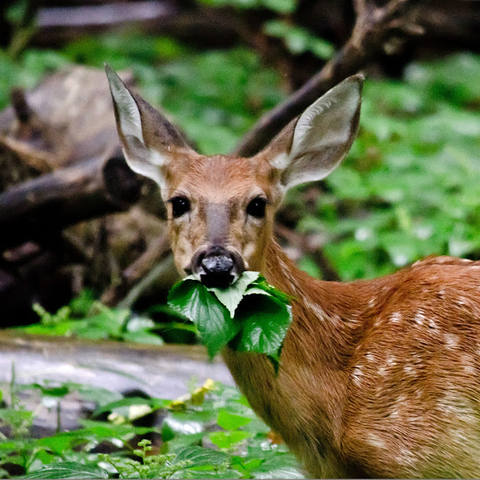Fall is a popular time when many people take to the woods. With deer hunting season well underway, it's a great time to learn more about a deer's diet and how to identify deer browse. Browse is a collective term for the leaves, twigs and buds of woody plants that deer and other animals like to eat; browse is also the verb describing this activity. Eating browse is an important part of what deer eat especially during the winter months when food is hard to come by.
If you're not seeing any deer while on your hunt, why not investigate the woods and look for evidence of deer browse?
Deer diet
A deer’s diet consists of a variety of crops, grasses, vegetation, acorns and nuts. A healthy deer will have a diverse diet with a variety of foods. Every day, a deer needs to eat about 6 to 8 percent of its body weight in green foliage and browse to stay healthy. For a 150-pound deer, that’s up to 12 pounds of food every day!
Too much browsing from deer can kill or limit the growth of tree seedlings, a fact that foresters and woodland owners know very well. Over decades, deer populations can greatly impact the look and feel of woodlands. Fortunately, knowing which tree seedlings are growing in your woods and which ones are browsed can give you more details on a deer’s diet.
Browse-sensitive trees
In Minnesota, tree species that rank high on a deer’s list include a number of conifer and hardwood trees.
- Northern white cedar and eastern white pine are two of the primary conifers that deer prefer to browse.
- Maples (sugar and red) and oaks are well-known hardwood trees that deer will browse.
- As you move east, eastern hemlock and yellow birch become preferred species where they are more abundant.
While deer prefer these tree species, they also avoid certain plants. Deer will start by browsing the most preferred or palatable trees first. If there are high populations of deer in an area, preferred plants will see more browsing, which can lead to other plants (that deer don’t like) outcompeting and taking over.
So what does it mean if deer are browsing spruce seedlings? Likely that deer are getting desperate and other food sources are limited.
Evidence of large deer populations in the past can be seen in a woodland that is dominated by invasive plants like buckthorn and garlic mustard, and even ferns. Deer avoid browsing invasive plants and ferns because they are not as digestible as other vegetation.
How to identify deer browse
The browse of deer on twigs can look similar to the browse made by other woodland creatures, like rabbits and hare. Deer are messy eaters, and you can find this when investigating a seedling. This is because deer only have incisors on their lower jaw and this requires them to “shred” their food. Browse from rabbits and other herbivores is always sharp and cut at an angle, due to the fact that they have incisors on both their upper and lower jaws.
More evidence of deer browse is the presence of a browse line on nearby trees. Think of northern white cedar growing along a lakeshore, where there are no green branches until about six feet up. In Minnesota, the browse line is typically around six feet, but with a deep snow depth and a hungry deer, the browse line could be closer to nine feet.
Healthy trees and woodlands
To have a healthy woodland, tree seedlings need to develop into healthy, mature trees. As an example, consider a browse-sensitive species like oak.
- First, it can take more than 30 years for an oak tree to produce acorns.
- Second, acorn crop years only occur every two to five years.
- Lastly, a single mature oak tree can drop as many as 10,000 acorns in a single year.
In these good crop years, acorns can be the majority of a deer’s diet in the late fall. If oak seedlings can never make it from seedling to sapling to healthy mature trees, the habitat quality for deer can suffer in the long term.
Knowing which species are being browsed can also give you insight into which methods can be used to protect seedlings.
Bud capping trees is commonly done to protect pines from winter deer browse. Bud capping involves attaching a small 3×4-inch piece of paper along the central bud of the seedling. For the central buds of oaks, a similar process can be used by using balloons instead of paper.
Although much more costly with more time and effort needed, fencing can be constructed around individual trees or larger areas several acres in size.
Protecting tree seedlings ensures that you have healthy trees for the future while steering deer towards other food sources.
The University of Minnesota Extension runs the Assessing Vegetation Impacts from Deer program to monitor the impacts of deer on vegetation across the state. The program is starting to receive lots of data from citizen scientists that monitor these impacts. Stay tuned for more information or look for more workshops across the state next spring!


